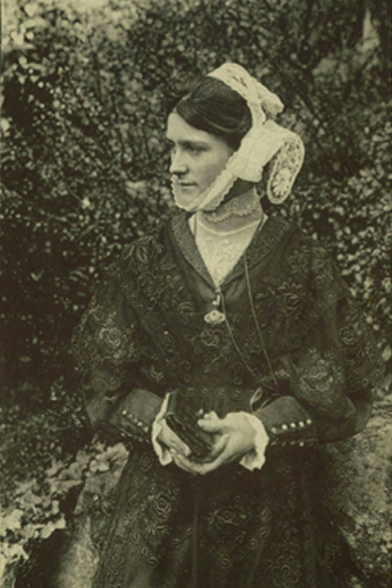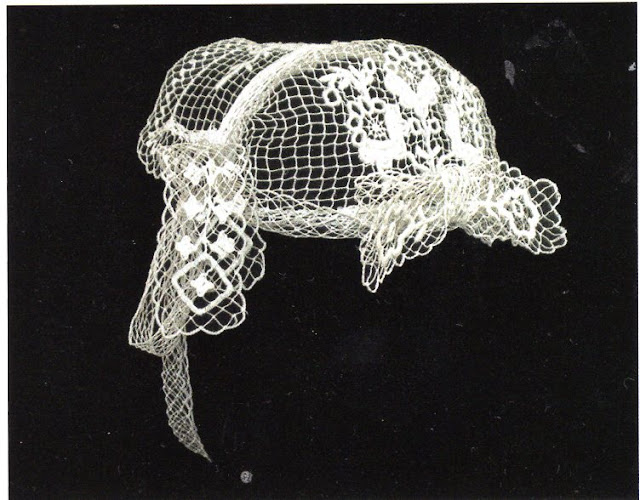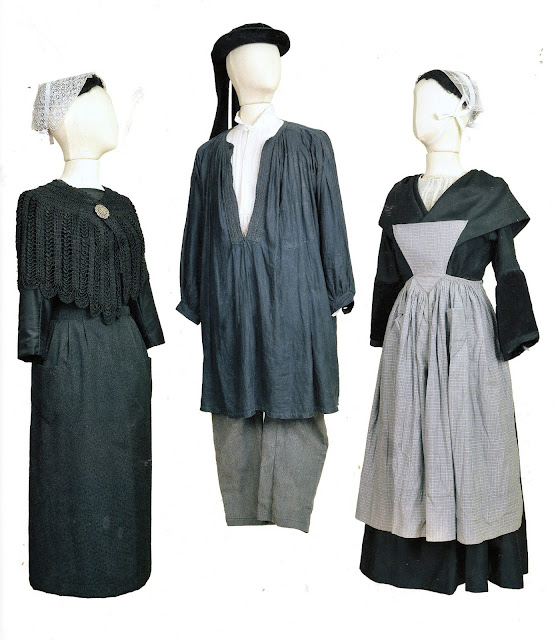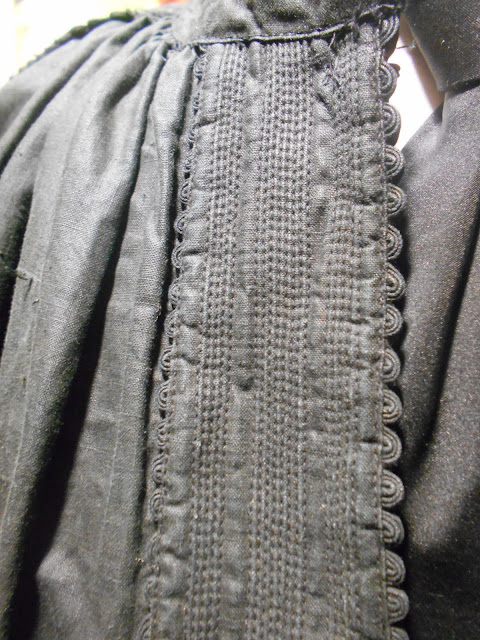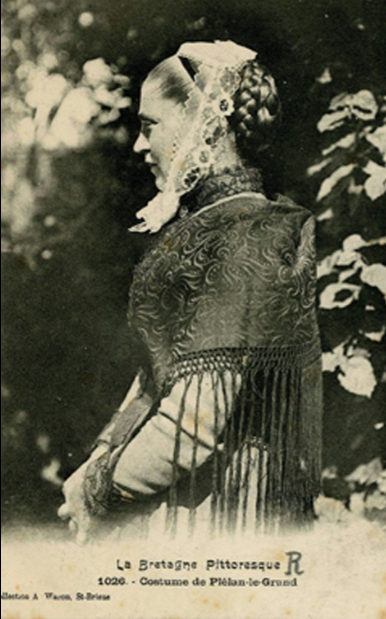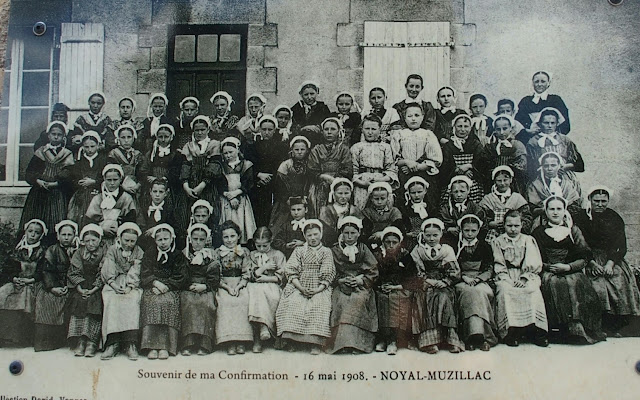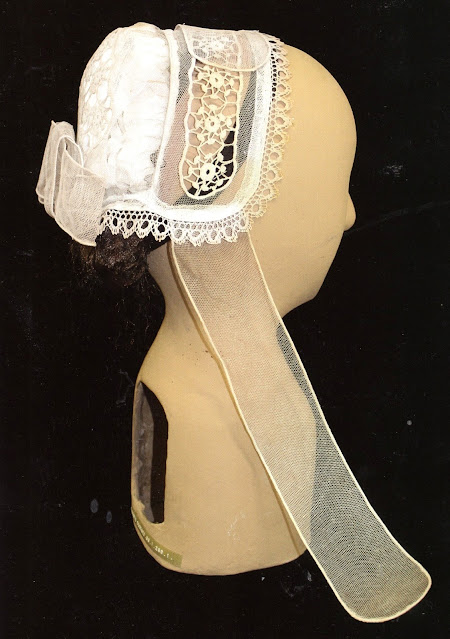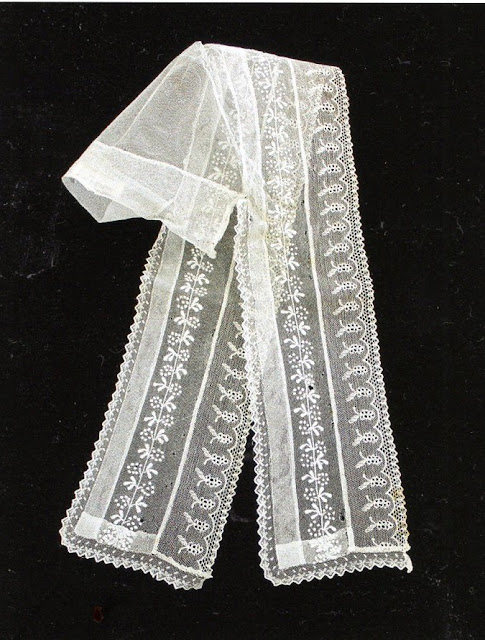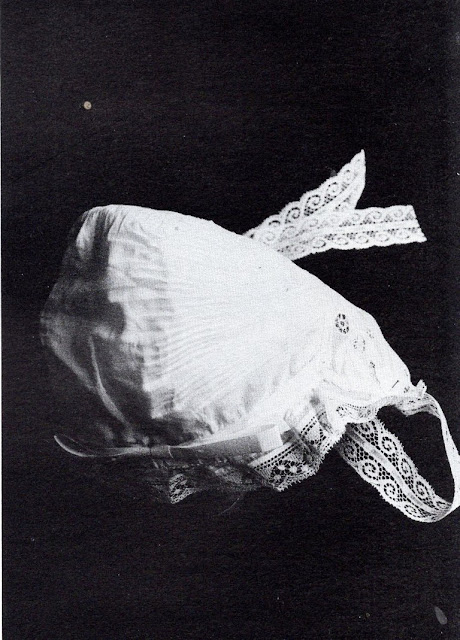
Hello all,
Today I will look at the costume of the eastern, or Gallo Speaking part of Gwened or Vannetais. The costume regions also include southern St Brieuc, southwestern St Malo, and small parts of Rennes and Vannes Provinces. This area, along with St Brieuc is considered Middle Brittany.
Bro Sant-Maloù in Breton
Paeï de Saent-Malò in Gallo
Pays de Saint Malo in French
Bro Gwened
Pays Vannetais in French


Maoron
Mauron in French
This costume region lies within the Province of St. Malo. It belongs generally to this group. The old coif of this region was a type of catiole, and was called the doubled coif. Here is a photo of this coif.
You can see that the front edge is doubled. The laces that gather the rear of the coif are wrapped around and tied on top. The wide wings were pinned to the top of the coif. It would have been worn with an undercoif with ribbons that passed under the chin and then tied on the side. This coif was abandoned around the turn of the 20th cent. and I have no images of someone wearing it.
The new coif resembles others that we talked about around St Brieuc and Vannetais Gallo. It shrank, but still had the doubled front edge. The wings became vestigial, the undercoif disappeared, but the ribbons were transferred to the coif itself. A second ribbon was tied in a bow and attached to the rear of the coif.
Another coif appeared at the same time, called the round coif, or the 'Marie-Louise'. This is essentially this coif merged with the polka, [see my article on Rennes] which was worn in neighboring areas. There is a gathered fringe of lace on the lower rear of the coif, the ribbon is tied in a flat bow in front of the neck.
Various images of this costume.
This woman is wearing a bridal crown over the coif, which has been pushed back. It would normally be supported by the hair being put up.
The rest of the women in this photo are wearing the costume and coif of Vannes.
The woman on the right is wearing the coif of Lorient.
Josilin, PloermaelJosselin, Ploërmel in French
As you can see, this costume region lies in eastern Gwened, but also southern St Brieuc and St Malo provinces.
Because this is a relatively large area, there are several local traditions. The under coif remained an important feature over most of this area.
In Josselin itself, the old formal coif was the catiole, worn in a more horizontal orientation than in Rennes.
Let us look at the old coif of Ploermel. Here is a drawing by Lalaisse showing two versions of the old coif. On top we see a version of the poupette, which was common to the east of this area. Below that we see the more ordinary coif of the region. Note that the wings are pinned to the top, and the undercoif has the area around the face enhanced with a curved cut and rows of ruched lace.
A couple of images of this coif.
Note the undercoif is well visible in this photo. These have not been starched or ironed.
Here is a view of the undercoif by itself.
A type of capot, here called beguine, was also worn. Lalaisse shows it being worn over the coif and undercoif.
The beguine continued to be worn as one of the coifs of the area, especially for everyday.
The beguine here was always worn with the undercoif. Later, they both became made of lace.
Later on, when the coif diminished, over most of this region the undercoif remained, with ribbons that tied under the chin. A ribbon was often wrapped around the back of the coif, forming a circle around the bun. It happened at times that the undercoif was embroidered on the back, and the coif was made of plain tulle to show the embroidery. The wings were pinned to the back.
Here are some images of various coifs of the area. This first is an embroidered undercoif from Serent.
Some images of the costume of this region.
In this image from Pleland, we see a variant of the polka bonnet.
Regini in Breton
Réguiny in French
I have not been able to find much from this region. I did find a note saying that the coif was similar to that of Josselin, but worn without an undercoif. The undercoif, however was not universally worn in the Josselin region. This drawing is showing a somewhat extended rear to the coif.
Roc'h-an-Argoed in Breton
Rochefort-en-Terre in French
This region may be considered the heart of Vannetais Gallo, even though, as you can see, it extends slightly into Nantes on the other bank of the Villaine. The image at the head of the article is from this region. The coif is called Gallese, and is made up of a square of tulle or lace with the wings attached. In general, the wings are pinned to the rear of the coif, and there is no undercoif. The shape is different than that of Josselin or Reguiny. Here is the old coif, followed by the new.
The costume itself is similar to that of Vannes, having much the same embroidery, but the front of the apron is cut much smaller, not coming to the shoulders.
Ar Roc'h-Bernez in Breton
La Roch in Gallo
La Roche-Bernard in French
This town lies on the southern bank of the Villaine. Here the rest of the Rochefort region is in pink, with Roche Bernard in red.
In 1636, a passing traveler wrote that in this town Gallo was spoken, but Breton was spoken on the opposite bank. This enclave is in the Naoned [Nantes] region, and old drawings show that the typical Nantes coif with its elongated rear was worn here as well.
This following example has been washed but not starched or ironed into its proper shape.
Here we see a later example made in lace with the proper 'heart shaped' folds in the rear part.
Here we see a later coif with shorter wings, again, washed but not ironed.
This coif is later yet, with almost no wings, but the rear of the coif, which is dominant in the Naoned form is properly ironed.
An urban based coif, the gogotte, developed here and was worn by certain social classes. This was worn over a hairnet, and the rear was likely fitted over a hair bun.
Finally, a version of the gallese coif, with undercoif, from across the river came to be worn in this area. Likely due to the close financial connections the city, via its bridge had with the north side. That is why this is considered to be part of the Rochefort region.
We can see these various coifs worn in these images.
Damgan & Beler
Damgan & Billiers in French
This region along the coast was traditionally Breton speaking, and so technically belongs to Lower Brittany, along with the coast further south, as far as the city of Baule-Escoublac.
The old coif was of the type called Gallese, as in the Josselin and Rochefort regions. Here is an example from the town of Ambon. You can see the casing at the bottom of the rear of the coif. A ribbon was threaded through this, then wrapped around the top of the coif, and returned to the rear and tied in a bow. The wings, here with the addition of a band of lace, were pinned to the top of the coif, not the rear, as was typical inland.
Here is an undercoif and coif from Penerv [Penerf in French], which lies on a peninsula southwest of Damgan. Note the heavy embroidery and ruched and piped lace on the undercoif, and the plain coif which lets the embroidery show through. Pinholes on the coif show that the wings were pinned to the top.
This photo shows a mass held in the town of Beler [Billiers in French] around 1900. You can see that the wings of the coif were let down during Church services for the sake of modesty. If you look closely, you can see that there is embroidery on the backs of the coifs.
Here is an old photograph taken in Damgan some time after this, you can see that both the coif and undercoif have diminished.
In this photo you can see that the undercoif has disappeared.
The rest of the images show the modern costume, from the 20th cent. The wings continue to be pinned to the top of the coif, in contrast to how they are worn further inland.
These images are from the museum of Damgan, and the local dance group.
This first image has the very large front piece of Vannes, and may be from slightly further west.
This dance group is wearing a variety of coifs. The leftmost one, and the 4th from the right are from Damgan.
This woman was not part of the presentation, but was in the audience.
Pennestin
Penestin in French
This is slightly further down the coast, on the other bank of the Villaine. I have found one undoubted photo from this region. You will notice that the wings of the two women are worn differently. The one on the right who lets them hang is unmarried. The one on the left who pins them back is married. Widows let them hang under the chin but pin the two ends together.
Redon
Although this region is part of the province of Gwened [Vannes], the costume in most of the region is more similar to that of Naoned [Nantes]. It is considered to be part of Upper Brittany.
In the west of the region, in Allaire and St Jacut, the coif was similar to that of the Rochefort region.
In the rest of the region, the coif was more similar to that of Naoned [Nantes].
In Nantes, the coif was first elongated, including the rear, as we saw in this drawing from Roche Bernard.
Later the front piece and wings diminished, and the elongated rear became the coif, with only a minimum of cloth on the front. Here we see a drawing from the late 1800's. Here we see that the front of the coif is greatly reduced, but it is still pinned to an under coif with ties that pass under the chin and are tied on the side.
Here are two views of a coif from around the turn of the century. Notice the very particular way in which the rear was creased.
Later, the coif was made of tulle, and the front and wings had been reduced to just a lace edging.
The coif was short, pointed at the rear, and kept the ribbon which wrapped around and tied in a bow at the nape of the neck. The heart shaped creases were a major feature of this coif.
Here are a couple of coifs from a museum which show embroidery at the rear. These are not properly ironed, and should have creases like the one above. The first one is also missing its ribbon.
A few more images showing the costume of this region. This first image shows the capote, worn for weather and for mourning.
This woman seems to be wearing a polka, which was typically found further north.
This photo is of a bride, who is wearing a bridal crown of fake orange blossoms over the coif.
I was unable to find a dance group from this region, but here is a video of the local Bagad, [pipe band].
And that concludes this portion of my study of the costumes of Brittany.
I will do one more article on the regions of Guerands and Nantes.
Thank you for reading, I hope that you have found this to be interesting and informative.
Roman K
email: rkozakand@aol.com
Source Material:
Victor Lhuer, 'Les Costumes Bretons', 2001
Pierre Jakez Helias, 'Coiffes et Costumes de Bretagne', Chateaulin, 1983
Josepj Jigourel & Yanna Fournier, 'Costumes de Bretagne', Brest, 2000
Bruno Helias, 'Breton Costumes', Florence, 1997
Yann Guesdon, 'Costumes de Bretagne', Quimper, 2011
Yann Guesdon, 'Coiffes de Bretagne', Spezet, 2014
R. Y. Creston, 'Le Costume Breton', Paris, 1974
Charles Freger, 'Portraits in Lace - Breton Women', London, 2015
Jean-Pierre Gonidec, 'Coiffes et Costumes des Bretons', Spezet, 2021
Pierre Rochereau, ' Coiffes et Costumes des Bords de Rance', Dinan, 1989
Simone Morand, 'Coiffes et Costumes de l'Ancien Comte de Rennes', Quimper, 1979














